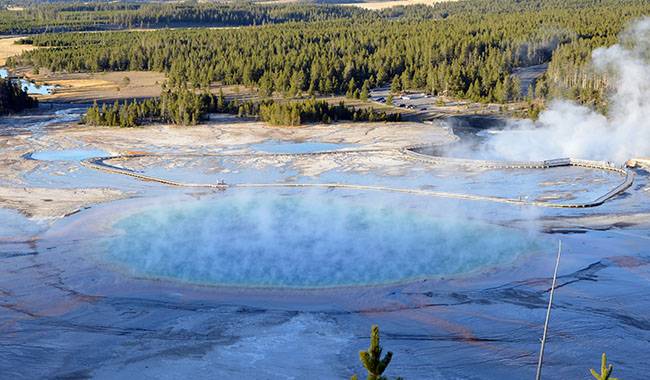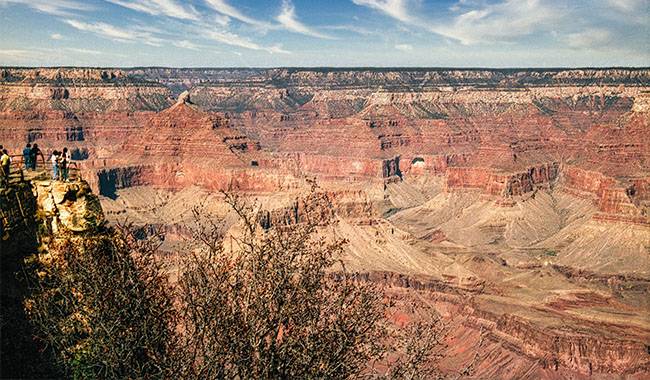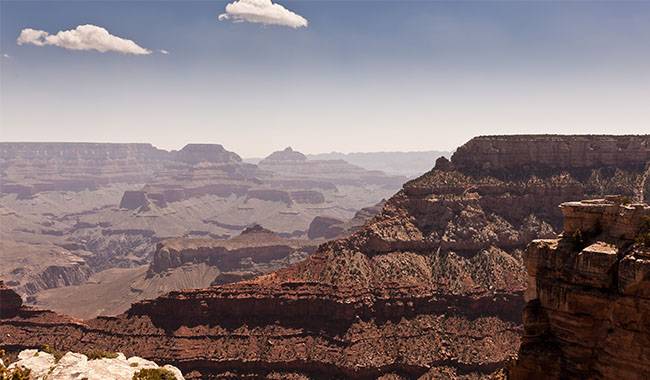
Each national park has its own beautiful attractions, but some iconic parks offer such striking sights that people make it a lifetime goal to see them at least once. And each has a day trek route that gives you the opportunity to see the park’s iconic beauty in a short amount of time. Here are the best of the best – 20 legendary day hikes in America’s national parks. You will learn more about The Hiking Paths of U.S. National Parks for a day in the LCN Outdoors article.
Choose appropriate clothing and footwear, and bring water and food with you when you set out. Try to maintain a measured pace of climbing and remember to take breaks. Of course, the best advice is to plan wisely and take into account all possible factors (from weather to equipment) to make your stay in the national park a truly memorable one.
Grand Canyon National Park, Arizona, USA
Park name: Grand Canyon National Park, Arizona, USA
Round trip: 6.5 miles (10.5 km)
When to go: Year-round
Difficulty level: Easy
The Grand Canyon is a scar on the surface of the desert that stretches for several 60 miles, cut by the Colorado River some 6 million years ago. It is a surreal picture, painted in red, brown, and yellow with many cliffs, breaks, and canyon spurs, with a mountain river flowing deep in the canyon. The easiest and most popular Rim Trail offers stunning views of the Grand Canyon from any point, but the unpaved section between Maricopa Point and Hermits Rest is a rather muddy and rocky section, more like a real trek than its paved counterpart. But what’s underfoot isn’t as important as what’s visible around it – the most beautiful panorama in the park (and possibly in the world) – a canyon within a canyon, with countless rushing rapids and rapids in the distance. It’s not for nothing that the Grand Canyon is called the “Tilted Range”.
At the end of the day, you can watch the sunset from here, and many people come specifically for this purpose, calling it a sight not to be missed. Use the park’s free shuttle system to get to the trailhead and back to Grand Canyon Village. You will make several additional stops along the way, allowing you to determine the route based on your level of strength and ambition. On the route west of the national park, try to get to Maricopa, Hopi, Mohave, and Pima Point – the views are much better there than elsewhere, and on the way to Hermit Rest, it’s best to sit on the right side of the bus as there is a point where you are on the right side of the canyon rim with a panoramic view.
Glacier National Park, Montana, USA
Park name: Glacier National Park, Montana, USA
Trail Highline
Round trip: 11.5 miles (18.5 km)
When to go: Summer
Difficulty level: Intermediate
Glacier National Park owes its dense green color on the west side to the humidity of the Pacific Ocean from the clouds. The legendary Highline Glacier Trail crosses Logan Pass to the Loop Trail to the Sun Road, which passes through the park’s alpine canopy and gives you a glimpse of all the park’s wild beauty – veritable glaciers and towering peaks, superb mountain scenery, wildlife, wildflowers, and waterfalls. Here you can encounter mountain goats, sheep, and bears. Below is the beautiful Lake McDonald, worthy of a postcard stamp – the largest lake in the park. There are several lodging options along its shores. Although the route crosses the American Continental Divide, it is surprisingly uncomplicated, mainly because it runs at an elevation of 0.4-0.45 miles (643-800 meters) (also thanks to the shuttle bus to the park). At the midpoint, the 0.6 miles (1 km) Grinnell Glacier Overlook Trail offers a view of the glacier’s rapid retreat. Take a break for a cold drink at the park’s historic Granite Lodge before descending to the loop trail on Road to the Sunshine for the return trip. The Highline Trail usually doesn’t get snow until mid to late July.

Mammoth Cave National Park, Kentucky, USA
Park name: Mammoth Cave National Park, Kentucky, USA
Wild Cave Tour
Round trip: 5 miles (8 km)
When to go: Year-round
Difficulty level: Effortless
A park in Kentucky contains part of the world’s longest cave system, known as Mammoth Cave. The karst cave system was formed about 10 million years ago in a thick bed of limestone beneath a sandstone formation at the base of Flint Ridge in the western foothills of the Appalachian Mountains. Most tours take you through the lighted portions of the cave (Grand Avenue, Frozen Niagara, and Fat Man’s Misery) with amenities such as ladders and handrails. Not so on the “wild” tours in the undeveloped parts of the cave, where you have to climb muddy and dusty passages with names like “Birth Canal” and “Passage to Nowhere” and so narrow that your boots have to go sideways. (If your chest or thighs are more than 3.5 feet, you should opt for a more traditional tour.) You’ll have to get your hands and knees dirty, do some goose-stepping, free climbing, and a big vertical descent deep into one of the world’s longest cave systems. It’s a six-hour route, and the reward for the arduous journey will be the opportunity to see dramatic limestone structures, such as the series of monumental domes of the Cathedral Dome, which most visitors never get close to. The Park Service provides outerwear, knee pads, and helmets, but you’ll need tall boots, a change of clothes, and shoes.
Yosemite National Park, California, USA
Park name: Yosemite National Park, California, USA
Round trip: 7 miles (11.2 km)
When to go: Spring to fall (the best time is late spring/early summer)
Difficulty level: Effortless
In Yosemite, you can be a spectator or a participant in an event. This event is a hike. It begins with a horizontal climb in Yosemite Valley – a 3.5 mile (5.6 km) climb with a 0.5 mile (810 m) drop – right to the top of the highest waterfall in North America, the fifth-highest point in the world. You’ll find yourself 0.45 mile (740 meters) above the dazzled people standing at your feet where Yosemite Creek Mountain Falls begins its descent from the granite rim of the valley.
Along the way, you’ll enjoy spectacular views of the usually under-appreciated Middle Falls, as well as views of the valley that will make you feel like a hiker on a big wall. If you don’t feel like walking to the top, a place worth turning back to is about 2 miles (3.2 km) from the start of the route and about 0.7 miles (1.1 km) after Columbia Rock, where you can see the middle section of the falls and the base of the mountain.
Black Canyon, Gunnison National Park, Colorado, USA
Park name: Black Canyon, Gunnison National Park, Colorado, USA
North Vista Trail to Exclamation Point Overlook
Round trip: 3 miles (4.8 km)
When to go: Spring to fall
Difficulty level: Intermediate
The park’s main geographic feature is a deep canyon (Black Canyon) through which the Gunnison River flows. Other canyons may be more magnificent, but few can match the steep rock walls, narrow entrances, and breathtaking depth of the Black Canyon. Canyons in the park range in depth from 0.3-0.5 miles (530-820 m) and have a minimum width of 40 feet (12 m). 0.3 miles (555 m) of canyon rim is only 0.1 mile (150 m) from the trail. The North View Trail begins just north of the ranger station and leads to a spectacular spot called Exclamation Point, 0.35 miles (570 m) from the bend in the Gunnison River. Views of the canyon can be seen from both directions. Ambitious travelers can continue to Green Mountain at an elevation of 0.15 mile (241 m) – a round trip of 7 miles (11.2 km) – for a bird’s eye view of the canyon as well as West Elk Mountain to the north and San Juan Mountain to the south. There is no trail to the bottom of the canyon, but you can follow SOB Draw (just east of the campground to the north) to the Gunnison River for trout fishing, which is very good. The return trip is very strenuous uphill (the canyon ranks as the fifth steepest in North America).

Shenandoah National Park, Virginia, USA
Park name: Shenandoah National Park, Virginia, USA
Loop tortoiseshell
Round trip: 2.8 miles (4.6 km)
When to go: Spring to fall
Difficulty level: Intermediate
Shenandoah National Park is situated on a narrow ridge in the Blue Ridge of the Appalachian Mountains. The park is crossed by Skyline Drive, which runs almost along the crest of the ridge. One of its advantages is that it provides access to hiking at the high points of the park. Along the road, there are dozens of lookout points on either side of the ridge. From the lookout points, hiking trails begin along the slopes of the ridge. There are five official campsites and three hotels, as well as opportunities for horseback riding and biking. The highest point in the park, Hawksbill Mountain, at 0.8 miles (1,287 meters), can be accessed from here. From the Hawksbill Gap parking lot, follow the old Native American trail, known as the Appalachian Trail, to the Salamander Trail and the summit. Observe deer, grouse, and peregrine falcons. The Appalachian Trail overlooks the Shenandoah Valley through a grove of oak trees. From the rocky terrace at the summit, you can see the whole world, with sweeping forested ridges, distinct hollows, and valleys, and the distinctive craggy outline of Old Lager faintly visible to the east. In windy conditions at the top, the Byrd’s Nest Shelter below the summit will provide a sheltered picnic spot. And don’t forget that there are bears in the park, so precautions should be taken to avoid attracting bears with food supplies. One of the attractions in the park is the waterfall. The highest one is Overall Run, with a drop of 95 feet (29 meters). There is a hiking trail leading to it from the road.
Arches National Park, Utah, USA
Park name: Arches National Park, Utah, USA
Devil’s Garden Trail leading to Scenic Arches
Round trip: 1.85 miles (3 km)
When to go: Year-round
Difficulty level: Easy
It’s a rare case where the name of a national park actually matches what can be seen there. This contains the largest concentration of natural sandstone arches (over two thousand!) ), including the world-famous and exquisite arches, there is nothing more inspiring than a landscaped arch. The longest arch in the world, at 290 feet (88 meters) long, like a soccer field, looks like a red rainbow and appears almost thin and long, tapering down to 70 inches (1.8 meters). Since the early 1990s, three large boulders have fallen off the top of the arch, so it is likely that it will soon collapse completely. Naturally, this is all surrounded by a landscape of sandstone hills interspersed with pine trees and bristlecone cypress.
Arch fans will especially enjoy this route, as it passes through two more arches – the tunnel and the pines – before the landscape arch. And there’s a chance to continue on to Devil’s Park and see five more on the 5.6 miles (9 km) round trip route. The geological history of the park is interesting – the main reason so many arches and other rock formations were formed here is thought to be a salt layer more than a thousand feet thick located somewhere underground. Under the weight of rock and mud, the salt base collapsed, creating the park’s landscape and the massive domes of the mountain range’s upper layers. At the same time, erosion has created a large number of vertical slabs on the surface that have been transformed into arches by water, ice, and wind. Leave as early as possible as there is limited parking and the summer is very hot.
Acadia National Park, Maine, USA
Park name: Acadia National Park, Maine, USA
Bluff Trail
Round trip: 1.85 miles (3 km)
When to go: Summer and fall
Difficulty level: Effortless
The park is a large area of forests, mountains, ponds, and lakes along the Atlantic coast of Maine.” The “Cliffs Trail” is the most challenging and well-known trail on the east side of Champlain Mountain. The trail is not a technical climb, but it is not for the faint of heart either. One of the park’s attractions, located on the eastern slope of Mount Champlain, is the Park Loop Road. Here you’ll find a parking lot and a small campground, as well as hiking trails leading to the top of the Terrell Cliffs. The vertical ascent is over 1,000 feet (304 meters). Despite the difficulties, the climb to the top of Champlain Mountain is one of the most popular hiking trails in Acadia. The trail begins in the forest off the road and seems fairly easy at first. Then there are cliffs with narrow ledges, metal handrails, and ladders. As you ascend, it becomes more challenging, but the risk and effort are more than made up for by the spectacular views of the eastern Desert Mountains with their ponds, meadows, mountains, cliffs, and coastal islands, Frenchman’s Bay, and the town of Bar Harbor. The trail is often closed in early summer when peregrine falcons are nesting on the hillsides. Rangers know the location of some nests with chicks and offer the opportunity to view them with binoculars. Check with the U.S. National Park Service for trail closures. This journey may take most of the day. When setting out, make sure weather conditions are favorable.
Great Smoky Mountains National Park, North Carolina, and Tennessee, USA
Park name: Great Smoky Mountains National Park, North Carolina, and Tennessee, USA
Trek to Mt. Kammerer and back
Round trip: 16 miles (26 km)
When to go: Spring through fall
Difficulty level: Effortless
This route follows some of the most remote sections of the Appalachian Trail and boasts some of the best views in the park. From the Big Creek Ranger Station in the northeastern part of the park, follow the Chestnut Branch Trail to the Appalachian Trail. Then head to Mount Carmel, about 1 mile (1,609 meters) above sea level, where a 0.6 mile (960 meters) spur leads to the Woodstock Fire Tower, a Depression-era artwork built by the Civilian Conservation Corps. From here you can see the eastern part of the park, with sweeping forested ridges stretching all the way to Tennessee. Follow the Big Creek Trail down. On the way back, pause to take a dip in one of the deep pools that cascade down the Big Creek Trail.
Mount Rainey National Park, Washington, USA
Park name: Mount Rainey National Park, Washington, USA
Summerland Trail
Round trip: 8.4 miles (13.5 km)
When to go: Summer
Difficulty level: Intermediate
Mount Rainier (stratovolcano), at 2.7 miles (4,392 meters), is the highest point in the Cascade Range. It is surrounded by valleys, waterfalls, subalpine flower meadows at 1.1 miles (1,800 m), old-growth forests, and over 26 glaciers. The volcanoes are often covered by clouds that pour down large amounts of rain, causing devastating floods. The route begins at Flegepan Creek, from where it heads up through the old-growth forest, getting steeper and steeper before reaching the valley where, on a clear day, you can see the mighty Mount Rainier. Amidst a dazzling show of wildflowers, another 0.6 mile (1 km) or so brings you to the summer garden meadows: lupine and lilies. Mountain goats and herds of elk can be found here, as well as the ubiquitous dry otter.